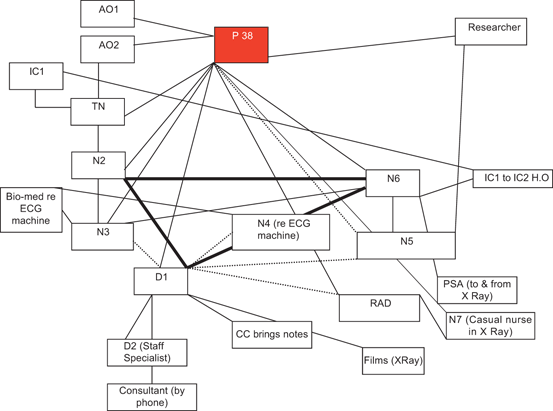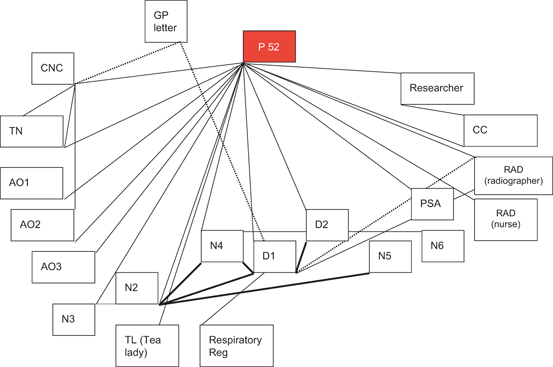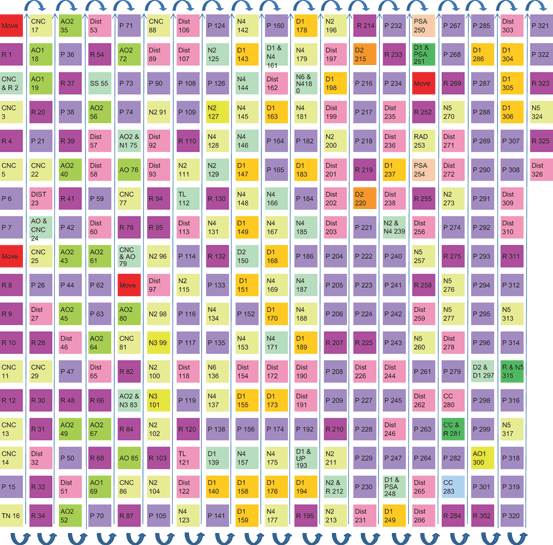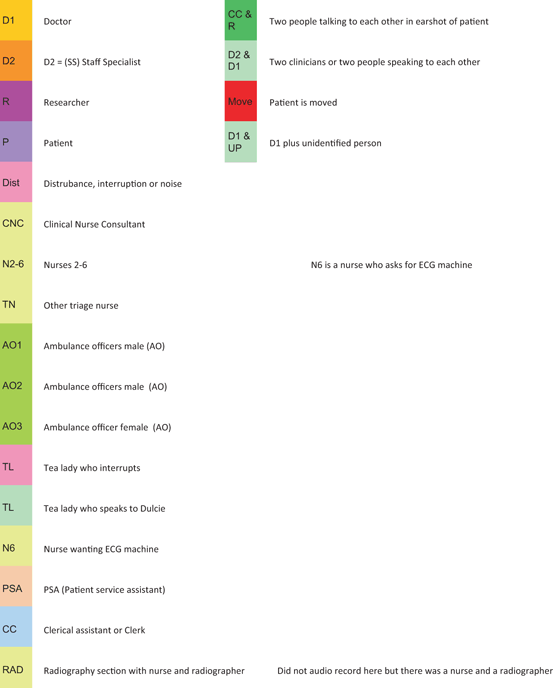Triage level
Description
Should be seen by provider within (min)
1
Resuscitation
0
2
Emergency
10
3
Urgent
30
4
Semi-urgent
60
5
Nonurgent
120
Nationally, most patient presentations fall into the latter three categories (Australian Institute of Health and Welfare 2013, p. 17). The increasing use of emergency departments by nonurgent patients is a worldwide phenomenon, and reflects many factors, including the 24-hrs accessibility and availability of emergency department care, patient’s desire to avoid prolonged waiting times for appointments in primary healthcare contexts, perceptions of emergency departments as one-stop healthcare sites for multiple tests and access to a range of specialisations and rising costs of healthcare in private settings (Durand et al. 2012; Committee on the Future of Emergency Care in the United States Health System 2006, pp. 38–39).
This increased demand for nonurgent care in the emergency department setting results in many patients experiencing extensive waiting time before being admitted. They are often unaware of the rationale behind triage, and are subsequently frustrated by the delay between their initial arrival at the emergency department and receiving treatment . The often unmanageable demand also increases the risks to patient safety inherent in the triage system. For example, many clinicians reported the limitations of this practice, citing lack of clinical expertise by the clinicians responsible for triage which can result in under-triaging (so underestimating critical nature of presenting condition), not considering differences in injury severities and survival probabilities between types of trauma, and not taking age into account (see Navin and Sacco 2010).
The increased number of presentations are associated with overcrowding, with widespread reports of overcrowding in emergency departments around the world raising doubts about the capacity of emergency services to provide safe care (Lowthian et al. 2012). There is increasing evidence that overcrowding affects patient safety. Bernstein et al. 2009, p. 1 state that:
A growing body of data suggests that ED crowding is associated both with objective clinical endpoints, such as mortality , as well as clinically important processes of care, such as time to treatment for patients with time-sensitive conditions such as pneumonia. At least two domains of quality of care, safety and timeliness, are compromised by ED crowding.
On 31 August 2014, hospital D’s emergency department clinical director said on the online edition of the daily ABC news that he was very concerned about the increased patient presentation numbers to the emergency department and that ‘current patient numbers are unsafe and unsustainable’.
He said that the presentations to the emergency department have increased by 7 %, and that overcrowding not only affects the patient experience but more critically their safety:
Once you’ve been seen and you have a diagnosis, how long you stay in emergency and how crowded emergency is has impacts on health. It increases time in hospital, it increases costs, it increases complications and in fact it increases mortality .(Dr Michael Hall, emergency department clinical director, online Australian Broadcast Commission news, 31 August 2014)
The continuing rise in patient presentations presents significant challenges to both the quality and safety of the patient experience, with significant evidence from around the world that the risk of adverse events is increasing due to overcrowding (Schull et al. 2002).
2.3.3 Short-term, Episodic Patient Care: The Lack of Familiarity Between Emergency Department Patients and Clinicians
Emergency departments are set up to provide short-term, episodic, urgent and life-saving care. The primary objectives of emergency department care are to determine as efficiently as possible a patient’s diagnosis , and to decide whether the patient can be treated within the emergency department and discharged, or whether they need to be admitted to the wider hospital or referred elsewhere for ongoing care and supervision. The challenge for emergency department clinicians is to make these determinations in the absence of any readily accessible medical records , known medical histories or established relationships with patients. In the words of one staff specialist we interviewed ‘Our patients are unknown, they’re new, so they don’t come in with the diagnosis tattooed on their forehead and that is often very difficult for people who don’t work in emergency to understand’ (staff specialist, hospital A) . Although some patients may return to the emergency department for follow-up care, for most, their relationships with their emergency department clinicians will cease following their discharge from the emergency department. As a result, it is imperative for patient safety that patients leave the emergency department with a clear understanding of their diagnosis and their clinician’s recommended treatment regimen postdischarge . Without this, as Perez-Carceles et al. (2010, p. 456) note, compliance with discharge instructions will be unlikely, as there will be no subsequent contact between clinicians and patients, and therefore no further opportunity for patients to clarify their understanding, or clinicians to ensure patient comprehension.
2.3.4 The Physical Environment: Noise Levels, Privacy and Comfort
A flow-on effect of the short-term, functional nature of emergency department care is that they are not designed for prolonged patient stays. As one clinician commented, the emergency department is ‘a terrible environment for people to sit in for 24 hrs, there’s no doubt about that. Our beds aren’t designed for people to stay, we don’t have enough showers, we don’t—we’re not meant to be that’ (senior staff specialist). Researcher observations of the physical environment of each emergency department we studied paint the picture of crowded, cold, sterile and clinical spaces, summarised in Table 2.2.
Table 2.2
Layout and space in the five emergency departments studied
Hospital A | Hospital B | Hospital C | Hospital D | Hospital E |
|---|---|---|---|---|
Crowded; cluttered walls; white; bright; few windows; cubicles defined by curtains | Beige; brown; clinical; ordered; windows; clean walls; cubicles defined by curtains | Windowless; ordered; antiseptic; bright yellow; cubicles defined by curtains | Has some windows; bright; antiseptic; cubicles defined by curtains | Windows in one part of acute; none in subacute or EMU; walls are green; cubicles defined by curtains |
Emergency departments are also notoriously noisy clinical environments, filled with the constant sounds of medical equipment, patient monitors, computers, overhead announcements, phone calls and conversations between patients and clinicians and amongst clinicians themselves. As Short et al. (2011, pp. 28–29) found, the highest noise levels tend to be in the resuscitation areas and acute sections of the emergency department, often exceeding established recommendations of sound levels for patient areas and wards. Exposure to high levels of constant noise in clinical settings has been correlated with increased agitation and psychological distress, patient confusion, staff exhaustion and medical and nursing errors (Short et al. 2011).
In our research, we found that the level of noise in the emergency departments frequently affected the audibility of patient–staff interactions, with clinicians and patients regularly needing to repeat themselves in order to hear one another. Further, as patient beds were often only separated from each other by curtains, this provided very little privacy for their occupants. Throughout our research we observed that often patient–clinician conversations were clearly audible from the next-door beds. As one intern (hospital A) said to us:
I often think … yeah I don’t … I think I would have to be seriously ill to go to an ED (laughter) just because I think it would be such a frustrating experience and particularly late at night because it never closes down … the lights are always on, there’s always noise and there’s always people and I think if I felt like that person probably feels, the last thing I would want would be a big noisy room with people running around and no one coming when I press my button and… so that sort of thing. So I think it’s a very frustrating and prolonged experience for them. I think once they’re on the wards it’s a little bit … far more sane ’cause it’s a little bit more settled.
2.3.5 Multidisciplinary Healthcare Teams
Emergency department healthcare teams are made up of doctors, nurses and allied health professionals (although the major disciplinary divisions are between doctors and nurses). All have different roles and priorities in the management and treatment of patients who present to the emergency department. Nurses will typically manage the ongoing care of patients in the emergency department (e.g. administer pain relief, monitor each patient’s stability and comfort) , while doctors will diagnose, establish a treatment plan and determine whether a patient can be discharged from the emergency department or admitted to a hospital ward for further observation and care. Notably, while the disciplines work side by side, in all but one of the emergency departments we researched, there was very little evidence of interdisciplinary collaboration throughout patient journeys. Rather, we observed clinicians attending patients’ bedsides individually and asynchronously, undertaking discipline-specific tasks and care. We also frequently observed tensions between doctors and nurses relating to the performance of tasks that traversed traditional disciplinary boundaries. The lack of interdisciplinary practice also led to a lack of familiarity between staff of different disciplines:
Junior doctor: Do you do lines?
Nurse: Not on him, he’s got terrible veins. Technically it’s your job doctor.
Junior doctor: I know.
Nurse: I don’t do lines, because I’m very good at blowing them.
And in another emergency department:
Junior doctor: Are you looking after the patient in bed 10?
Nurse: I’m a float nurse.
Junior doctor: Is that a ‘yes’ or a ‘no’?
Nurse: That’s a ‘no’.
In the following sections, we discuss that the multidisciplinary nature of emergency department care will often translate to different communicative roles being undertaken by nurses and doctors in their interactions with patients. It also produces complex networks of care that surround each patient’s journey in the emergency department.
2.3.6 Joint Role of Emergency Departments as Training Facilities
In Australia, as elsewhere, emergency departments are training grounds for junior doctors and nurses. As the final report of the Special Commission of Enquiry into Acute Care Services in NSW Public Hospitals pointed out, most of the acute care services for noncritical patients are performed by junior doctors (interns, residents, registrars, career medical officers and locums) . In essence the report notes, Australian acute health services are training grounds for junior doctors. (Garling 2008, p. 428).
Junior clinicians with varying levels of experience and expertise learn on the job and predominantly focus on the immediate clinical task in front of them. A central component of the work of senior clinicians is supervising and guiding their junior colleagues. In all emergency departments we researched, however, senior clinicians (both nurses and doctors) were far less in number than their junior counterparts, which stretched the capacity of senior staff to perform their supervisory roles. As a director of one emergency department explained in reference to the medical discipline: ‘Junior medical staff … they’re learning so … they’re going to make mistakes … And we are understaffed with consultants here. So [as a senior doctor] when you’re on the floor you’ve got everybody coming at you all the time for 10 hours looking for direction’. Indeed, across our interviews, nearly all senior clinicians described the key challenge of their work as stemming from the constant interruptions they faced as they multitasked their competing responsibilities of supervising junior colleagues, performing direct clinical care and facilitating patient flow across the department. This was particularly emphasised by senior medical staff members who bear the primary responsibility not only for individual patient diagnosis and disposition decisions, but also for negotiating the transfer of patients from the emergency department to other hospital wards. As one senior staff specialist explained:
The ability to function … is impaired dramatically by the constant interruptions that happen and that’s not a criticism of anybody it’s just the way that we work. I tracked it one shift and you know, one shift—I think I answered the ’phone 20 times, I saw eight of my own patients, I reviewed 20 of the interns’ (junior) patients in person and discussed another 15 or 20. If you sort of divide 60 or 70 little work tasks into an eight or ten-hour day you realise that’s why you never get to concentrate. And that’s very difficult—to concentrate on one, to force yourself to concentrate on one thing when there are other things going on.
This tertiary teaching function of emergency departments, although not often explained to patients, plays out throughout the patient’s journey, and becomes particularly visible through the order in which patients, triaged in the less urgent categories of 3–5, will encounter and interact with junior and senior doctors . As will be discussed further in Chap. 3, junior doctors will generally be the ones who carry out the emergency department patient’s first medical consultation. They will take the patient’s history and explore their condition, then formulate their test plans and an initial diagnosis . The junior doctor will then consult with a senior doctor who, as noted above, has overall responsibility for the patient’s ultimate diagnosis and disposition.
Depending on the complexity of the patient’s presentation, the senior doctor may then conduct another consultation with the patient, either with or without the junior doctor, to confirm the junior doctor’s initial assessment. What this means for the patient is that they will often encounter at least two doctors over the course of their emergency department care, with varying levels of expertise and experience. Further, as senior doctors double-check the clinical assessments of their junior colleagues, patients will frequently find themselves being asked the same questions over and over again, without being aware why this is happening.
2.3.7 Time Constraints
Emergency department staff and patients are constrained by time in far more extreme ways than in other professional or private contexts. Few emergency department participants (clinicians and patients) have any real control over their own time and the time taken for medical analyses. Staff members are pressured to move, talk and think quickly, while patients can spend long periods in holding patterns, waiting on results, diagnoses, X-rays and returning staff. Since we conducted this research, the Australian Federal Government has introduced a National Emergency Access Target (‘NEAT’) which requires most patients to be diagnosed, treated and discharged from Australian emergency departments within 4 h. Modelled on the UK’s National Health Service Plan , the target was driven by research and state government inquiries linking prolonged waiting times with poor patient health outcomes (Crawford et al. 2013, pp. 2–3). To date, there has been little research which has investigated the impact of NEAT on the overall quality of emergency patient care in Australia. It remains to be seen whether its introduction has indeed improved patient outcomes, or whether the added time pressure on staff to process patients through emergency departments has compromised the interpersonal dimensions of emergency care and other benchmarks of quality healthcare practice (Crawford et al. 2013).
2.3.8 Face-to-Face Spoken Communication
Face-to-face spoken communication dominates emergency department work. Indeed, emergency medicine can be characterised as a predominantly spoken discipline (Coiera et al. 2002, p. 417; Spencer et al. 2004; Woloshynowych et al. 2007; Kee et al. 2012, p. 297). Clinicians will talk to patients, to each other, to hospital staff and to clinicians and health workers in the broader healthcare community, with written records playing a secondary role. In the previous observational studies of emergency department, clinicians’ work have shown that clinicians will engage in between 36 and 49 communication events per hour (Coiera et al. 2002, p. 416). As described above, the communication loads for clinicians will often increase according to higher levels of seniority (see also Fairbanks et al. 2007, p. 403), and be characterised by interruptions and multitasking. Indeed, one senior doctor we interviewed estimated that over the course of his shift, he would speak to at least 100 different people:
I will talk to patients, I talk to patients’ families, I would talk to all the other members of staff, both nursing and medical staff and also the various Allied Health staff such as physiotherapists. I would talk to the diagnostic support infrastructure such as having negotiations with the pathology department, the X-ray department. I would talk to the ambulance staff. I would talk to the clerical staff and I would talk to representatives of the in-patient teams. And many days I have gripes about various things and I talk to the administration as well. So I would talk to quite possibly 100 given people in a day. (Staff specialist)
Every one of these spoken interactions can potentially involve a misunderstanding, a subtle change of meaning or interpretation, and as that information then gets passed onto someone else, the chance of changed nuances or of information omitted or forgotten is very high. This is particularly the case in clinical handover where often crucial patient information is not picked up on, not written in their medical records or inaccurate (see Eggins and Slade 2012; Eggins and Slade forthcoming). Pressures of time and tradition also mean that a lot of what is spoken is not recorded in the patient’s written records, although there is a growing policy emphasis on improving written healthcare communication in these settings. As you will see in Figs. 2.1, 2.2, 2.3 and 2.4 below, spoken communication load for emergency department patients also tends to be exceptionally high. They must communicate the nature of their symptoms and their histories within a relatively short period of time and to a multitude of staff, and comprehend complex information provided by many different clinicians.
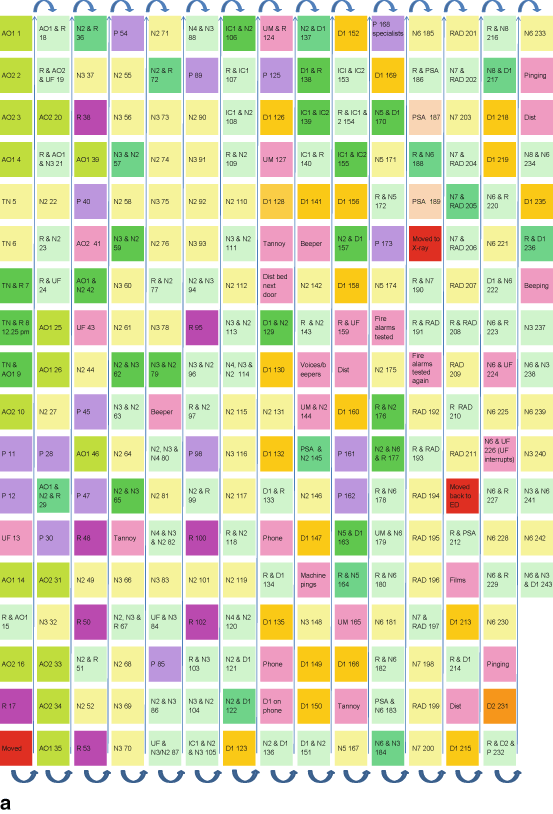
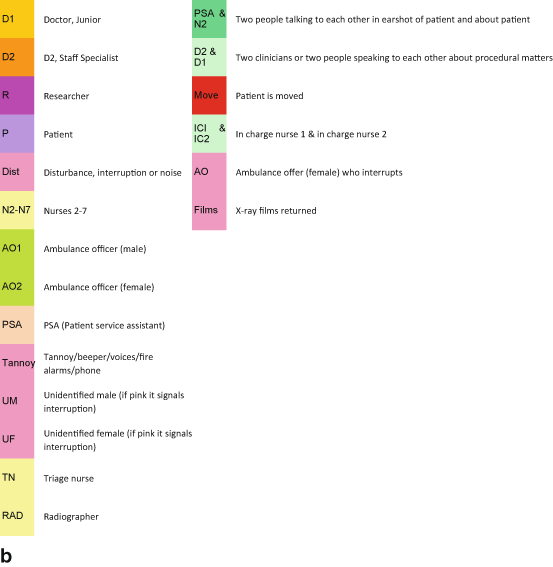


Fig. 2.2
Sequence of interactions with and around Denton

